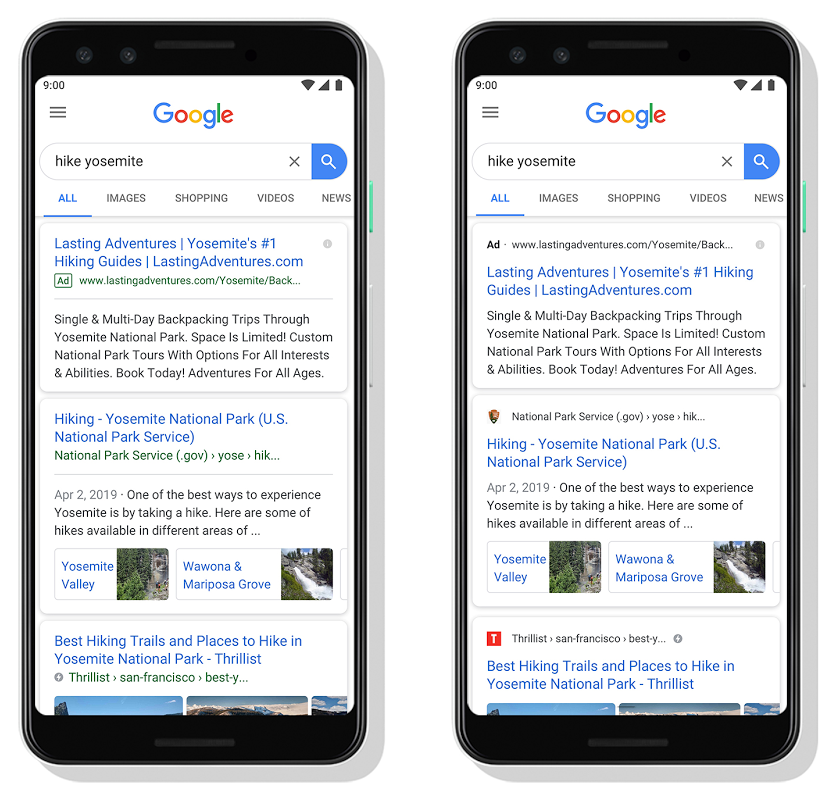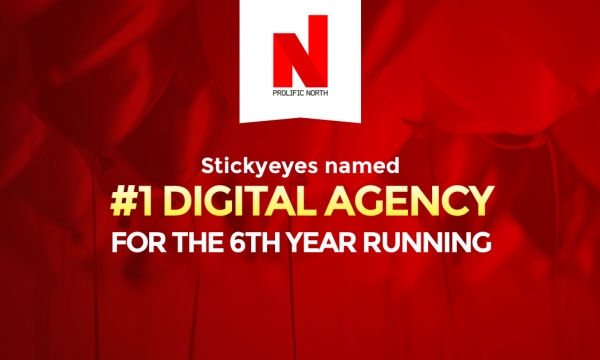Google recently rolled out “A New Look For Google Search”, updating the way that paid and organic listings appear on mobile. The change, which puts a website’s branding “front and center” of the SERPs, is focused on “helping you better understand where the information is coming from and what pages have what you’re looking for”.
So, what’s changed from a PPC perspective?
There are three main changes that you might have noticed in recent months:
1. The ‘Ad’ icon has changed from green to black, with the rectangular box around the word ‘Ad’ removed;
2. Landing pages are now displayed above the headlines, rather than between the headline and description lines as before; and
3. Organic listings now feature icons within the search results, where the ‘Ad’ icon now appears on paid search.

So, how does this affect PPC?
While it’s still early days of the new view rolling out across mobile, there are several ways that this could affect your paid results:
- Removing the old green ‘Ad’ icon in favour of a bold black label enables the paid result to blend in to the SERPs, potentially making the ad more difficult to distinguish against organic listings. This could lead to a surge in click volume from users who traditionally do not click through on paid advertising.
- The inclusion of icons and logos against organic listings could have interesting effects on PPC campaigns. On brand searches, these icons will allow a user to quickly scan the SERP and, at a glance find the company logo, and brand site, that they are looking for within organic results. The icons also provide more colour to organic listings as opposed to the bold black ‘Ad’ label attached to paid, which could be more visually appealing for the user.
- The change in ad layout also means that the landing page URL is now the first visible part of the ad itself. While headlines remain larger and more colourful to attract attention directly to the ad messaging, this alteration could throw greater importance behind landing page selection.
How to prepare your ads to make the most of the mobile SERP update
So, what you can do to ensure that your paid ads don’t just survive but positively thrive in this recent update?
Tie in search queries to your ad copy
While granular ad copy has always been important, it’s becoming more crucial to tie up PPC messaging with specific search queries. DSA and RSA ad campaigns can help to automate this process to a degree, but we also recommend reviewing any expanded text ads to ensure that headlines, descriptions and pathways are as relevant to individual search terms as possible. With organic listings now boasting company logos and icons, it’s more important than ever that PPC ad copy catches the attention of the user. Featuring the exact search query of that user in your ad copy is one of the best ways to ensure that your ad gets noticed.
Make the most of ad extensions
Using the full suite of ad extensions, where possible, across your campaigns is a great way to increase the chance of your ads being noticed. Not only will this help to provide more information and help to boost ad relevancy across Google but, an extended mix of sitelinks will also ensure that your higher-ranking paid ads occupy as much space as possible towards the top of the SERPs. By giving the user as much information as possible within your ad, you reduce the chance that they will have to scroll through various paid and organic results before deciding where to place their click and ultimately convert.
Help to maximise the impact of URL’s
With landing pages being the first piece of text visible on the PPC ad, the importance of how a final URL is displayed has never been greater. Google say that giving the user the ability to “quickly identify where the information is coming from” is at the forefront of this new look and so it’s key for advertisers to showcase the relevance of their landing page towards a user’s specific search term. We recommend increased granularity across paths 1 and 2, down to a keyword-group level or even individual keyword level to maximise the impact of URLs.
Increase the regularity of device performance
This update has initially only been rolled out across mobile, with no clear timeframe on if or when desktop search results will follow suit. Throughout the implementation of this new SERP, we recommend increasing the regularity of your device performance reporting to identify any shifts in traffic or total performance. By keeping a close watch on device fluctuations, you can identify any campaigns, keywords or individual ads that have been impacted and optimise accordingly. Keeping a record of device performance over this time will also help you to anticipate any expected changes in PPC performance if this update is rolled out across all devices and helps you to focus on any campaigns that were particularly weak or strong.
And, what about organic search?
But of course, this update doesn't only affect PPC ads. Improvements in promoting brand with both the favicon and URL/breadcrumb featuring higher on the SERPs provides a great opportunity for organic listings to pick up a greater proportion of brand traffic as part of a holistic approach to search. Determining which icon to use, which is impactful but also conforms to Google guidelines is important, as is using structured data to ensure Google displays a structured breadcrumb instead of a raw URL in the SERPs.
Moving forward, Google have said they made this change to support the upcoming addition of new content formats and actions that will be available directly from the SERP such as buying cinema tickets and streaming podcasts. As always, you can expect us to continue to monitor the impact of ongoing improvements and we’ll share any insight with you on our blog.


